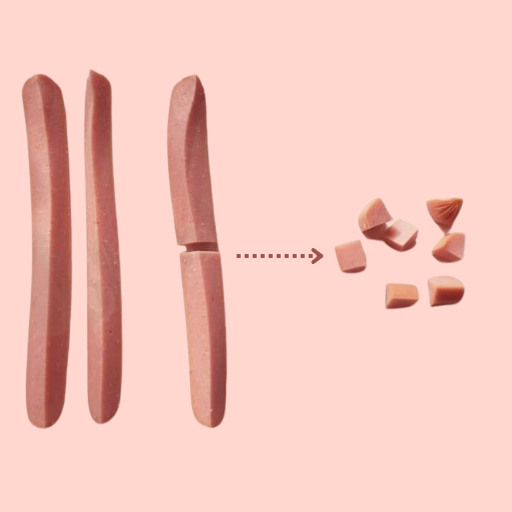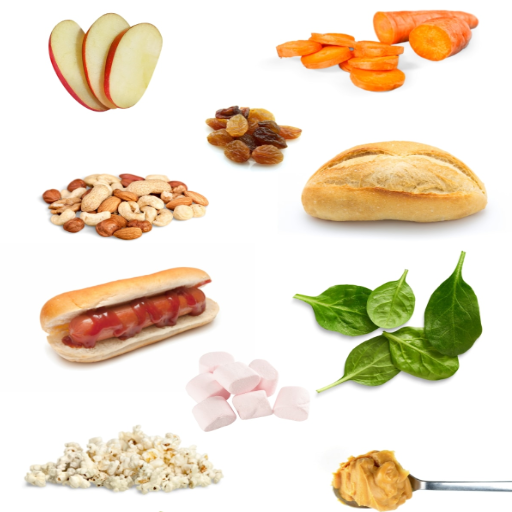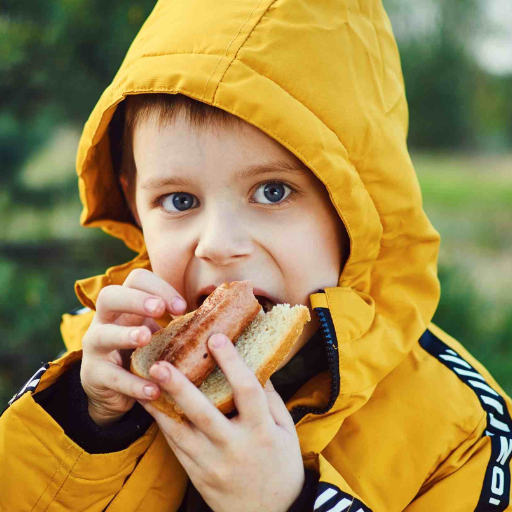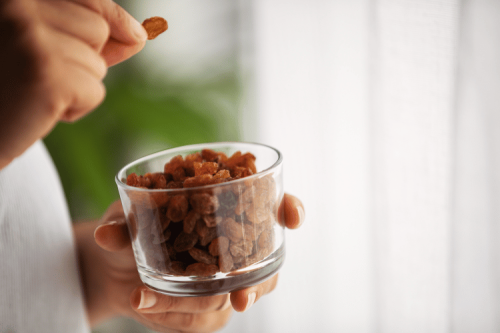
While providing lunch or snacks for toddlers, including specific foods that can be likely choking hazards, remains a safety concern, it might be best to avoid such foods. Hot dogs are one such food item, which seems very common for toddlers but is directly related to choking risk. This article will explore the hot dog subject, ponder developmental, socio-economic, and cultural eating habits, and share essential tips on avoiding hot dog hazards. In addition to a summary of the risky anatomical features of hot dogs, parents can also find Cups Pancakes, valuable tips on preparing and feeding your child without putting them in harm’s way. By knowing these dangers and ways to avert them, parents and caregivers can keep a safer eating place for children while still feeding them hearty and much-loved hot dogs.
 Hot dogs become a choking hazard due to their soft and tubular geometry. Hot dogs are best eaten when cut into slices; otherwise, they can block the trachea of a toddler. The internal surface of the throat makes it extremely difficult to free a hot dog in case it gets stuck around, as one can quickly ingest hot dogs owing to the hot dog's soft structure. Moreover, toddlers have inhibited chewing ability, further increasing their risk of swallowing large chunks of hot dogs, thereby enhancing their chances of choking. Therefore, they must be prepared and handled with care to avoid any possible risk of choking.
Hot dogs become a choking hazard due to their soft and tubular geometry. Hot dogs are best eaten when cut into slices; otherwise, they can block the trachea of a toddler. The internal surface of the throat makes it extremely difficult to free a hot dog in case it gets stuck around, as one can quickly ingest hot dogs owing to the hot dog's soft structure. Moreover, toddlers have inhibited chewing ability, further increasing their risk of swallowing large chunks of hot dogs, thereby enhancing their chances of choking. Therefore, they must be prepared and handled with care to avoid any possible risk of choking.
 Cutting hot dogs safely for children involves a few straightforward steps that significantly reduce the risk of choking. Begin by slicing the hot dog lengthwise to create halves or quarters, which lowers the likelihood of the pieces blocking the airway. Following this, cut the long strips into smaller, bite-sized pieces no larger than a pea, making them easier for toddlers to chew and swallow. Remember that the shape is as essential as the size—flattened or irregularly shaped pieces are preferable as they are less likely to cause obstruction. Always supervise children while they eat to ensure they are consuming their food safely, and encourage them to sit down and eat slowly for further precaution.
Cutting hot dogs safely for children involves a few straightforward steps that significantly reduce the risk of choking. Begin by slicing the hot dog lengthwise to create halves or quarters, which lowers the likelihood of the pieces blocking the airway. Following this, cut the long strips into smaller, bite-sized pieces no larger than a pea, making them easier for toddlers to chew and swallow. Remember that the shape is as essential as the size—flattened or irregularly shaped pieces are preferable as they are less likely to cause obstruction. Always supervise children while they eat to ensure they are consuming their food safely, and encourage them to sit down and eat slowly for further precaution.
 Regarding food types, especially with young kids, one better stay away from items structured as hot dogs, concerning their quenching risk. For instance, cut grapes in 1/4 sections for choking hazards because of their oval or round, naturally slippery shape that can easily be stuck in a throat. Nuts and seeds, mainly whole or large pieces of nuts and seeds, also fall under considerable scopes and risks, making them necessary to avoid or be chopped finely. Airy and fluffy popcorn poses choking risks, as does peanut butter, because it can get stuck on the throat or the roof of one’s mouth. In the case of hot children being a bit underage, these activities are out of their scope: long jellies and gum, though inhaled, may also suffocate them. So, with the said considerations, be watchful during meal or snack time for the children’s safety.
Regarding food types, especially with young kids, one better stay away from items structured as hot dogs, concerning their quenching risk. For instance, cut grapes in 1/4 sections for choking hazards because of their oval or round, naturally slippery shape that can easily be stuck in a throat. Nuts and seeds, mainly whole or large pieces of nuts and seeds, also fall under considerable scopes and risks, making them necessary to avoid or be chopped finely. Airy and fluffy popcorn poses choking risks, as does peanut butter, because it can get stuck on the throat or the roof of one’s mouth. In the case of hot children being a bit underage, these activities are out of their scope: long jellies and gum, though inhaled, may also suffocate them. So, with the said considerations, be watchful during meal or snack time for the children’s safety.
 If you notice a child is in the process of choking on a hot dog, there is no need to panic. First of all, check whether the child experiences difficulty with breathing, coughing, or has an expression of panic, which are signs of choking. If the child cannot cough or speak, take five deep breaths, blow downwards, and use the heel of your palm to strike firmly the blade between their shoulders. If the child begins to cough, the object is partly dislodged and does not need removal. If that does not work, deliver five upward thrusts to their stomach, commonly known as the Heimlich maneuver. In other words, where there is a will, there is a way. Also, try doing this until the child starts to breathe. If you see the child still resisting professional help, immediately contact emergency services.
If you notice a child is in the process of choking on a hot dog, there is no need to panic. First of all, check whether the child experiences difficulty with breathing, coughing, or has an expression of panic, which are signs of choking. If the child cannot cough or speak, take five deep breaths, blow downwards, and use the heel of your palm to strike firmly the blade between their shoulders. If the child begins to cough, the object is partly dislodged and does not need removal. If that does not work, deliver five upward thrusts to their stomach, commonly known as the Heimlich maneuver. In other words, where there is a will, there is a way. Also, try doing this until the child starts to breathe. If you see the child still resisting professional help, immediately contact emergency services.
 Careful attention should be paid to the environment, and food served to prevent choking incidents during mealtime. Ensure that children are seated upright and supervised at all times while eating. Prepare food to appropriate sizes for the child's age, cutting small, round foods such as grapes and cherry tomatoes into quarters. Encourage children to eat slowly, chew thoroughly, and avoid talking or laughing with food in their mouths. Additionally, discourage walking or running while eating to minimize risk further. Creating a calm mealtime atmosphere without distractions can significantly reduce choking hazards, ensuring safe and enjoyable experiences for children and caregivers alike.
Careful attention should be paid to the environment, and food served to prevent choking incidents during mealtime. Ensure that children are seated upright and supervised at all times while eating. Prepare food to appropriate sizes for the child's age, cutting small, round foods such as grapes and cherry tomatoes into quarters. Encourage children to eat slowly, chew thoroughly, and avoid talking or laughing with food in their mouths. Additionally, discourage walking or running while eating to minimize risk further. Creating a calm mealtime atmosphere without distractions can significantly reduce choking hazards, ensuring safe and enjoyable experiences for children and caregivers alike.
Why Do Hot Dogs Pose a Choking Hazard?
 Hot dogs become a choking hazard due to their soft and tubular geometry. Hot dogs are best eaten when cut into slices; otherwise, they can block the trachea of a toddler. The internal surface of the throat makes it extremely difficult to free a hot dog in case it gets stuck around, as one can quickly ingest hot dogs owing to the hot dog's soft structure. Moreover, toddlers have inhibited chewing ability, further increasing their risk of swallowing large chunks of hot dogs, thereby enhancing their chances of choking. Therefore, they must be prepared and handled with care to avoid any possible risk of choking.
Hot dogs become a choking hazard due to their soft and tubular geometry. Hot dogs are best eaten when cut into slices; otherwise, they can block the trachea of a toddler. The internal surface of the throat makes it extremely difficult to free a hot dog in case it gets stuck around, as one can quickly ingest hot dogs owing to the hot dog's soft structure. Moreover, toddlers have inhibited chewing ability, further increasing their risk of swallowing large chunks of hot dogs, thereby enhancing their chances of choking. Therefore, they must be prepared and handled with care to avoid any possible risk of choking.
Shape and Texture of Hot Dogs
Young Children have been found to choke on hot dogs due to their shape and texture customarily; hot dogs are round and smooth, placing them squarely at risk of getting stuck in a toddler’s lung area. This is mainly because children may swallow hot dogs without chewing. Compression of the fused throat areas can result due to the soft texture of a hot dog. These attributes combined mean that if a hot dog becomes stuck, expelling through coughing becomes challenging. These sausages should be cut lengthwise before cutting them into small pieces to reduce the likelihood of hot dog-related choking. Making sure young children are chewed thoroughly and are locked out from unsupervised consumption can further reduce these dangers.How Hot Dogs Get Lodged in the Throat
The cylindrical and smooth hot dog shape as a reason it is kids who often choke while eating. Because of that, kids may bite hot dogs and swallow them without chewing a lot. Such cases can also happen with kids still acquiring chewing abilities because the portions they swallow are not crushing ghastly enough and are just proper to be lodged at the trachea. On top of that, considering that little to no effort is required to bite on a hot dog, it is straightforward for someone to slide onto a place that would cut off their breathing. Hot dogs could be a problem, so when giving them to kids, the monitor should always look after them after placing the cut portions, as experts suggest.Recommendations by the American Academy of Pediatrics
AAP has provided specific recommendations for reducing the risk of choking while consuming hot dogs. According to them, hot dogs should be cut longitudinally and then cut into small pieces, for this practice will lessen the chance of the piece of meat being stuck in a child's throat. This general technique should be accompanied by supervision whenever the children are eating, whereby encouragement is given to children during mealtimes to enhance chewing before swallowing the food. There are specific parameters of being respectful of food while eating outlined by children; children need to eat at a limited pace and be attentive when eating. Sausages may also be offered when cut into pieces tiny enough to be chewed thoroughly or 0.5 inches at maximum for toddlers. Lastly, parents and caregivers should also receive appropriate training in rescue procedures such as Heimlich to prevent choking trauma situations in the child.How to Safely Cut Hot Dogs for Kids
 Cutting hot dogs safely for children involves a few straightforward steps that significantly reduce the risk of choking. Begin by slicing the hot dog lengthwise to create halves or quarters, which lowers the likelihood of the pieces blocking the airway. Following this, cut the long strips into smaller, bite-sized pieces no larger than a pea, making them easier for toddlers to chew and swallow. Remember that the shape is as essential as the size—flattened or irregularly shaped pieces are preferable as they are less likely to cause obstruction. Always supervise children while they eat to ensure they are consuming their food safely, and encourage them to sit down and eat slowly for further precaution.
Cutting hot dogs safely for children involves a few straightforward steps that significantly reduce the risk of choking. Begin by slicing the hot dog lengthwise to create halves or quarters, which lowers the likelihood of the pieces blocking the airway. Following this, cut the long strips into smaller, bite-sized pieces no larger than a pea, making them easier for toddlers to chew and swallow. Remember that the shape is as essential as the size—flattened or irregularly shaped pieces are preferable as they are less likely to cause obstruction. Always supervise children while they eat to ensure they are consuming their food safely, and encourage them to sit down and eat slowly for further precaution.
Best Ways to Cut Hot Dogs for Toddlers
- Longitudinal Slices: Cut the hot dog lengthwise into at least four quarters. This reduces the hot dog’s round shape, minimizing the risk of it becoming lodged in a toddler’s throat.
- Small, Bite-Sized Pieces: Once quartered, cut each section crosswise into small, bite-sized pieces no more significant than half an inch. This size is more manageable for toddlers to chew and swallow safely.
- Flatten and Shape: Flattening the pieces or creating irregular shapes can further reduce the risk of choking because these shapes are less likely to block the airway than rounded pieces.
Cutting Hot Dogs Lengthwise to Reduce the Choking Risk
Before chopping a hotdog into four parts, I must remember some significant points. I steer clear of round shapes as they form into quarters, which are more prone to choking hazards, especially for children aged 3 to 6. I chop these quarters into smaller pieces with a diameter of around half an inch. Kids are always a choking hazard, so while I allow them to chew on the pieces, I try to manipulate their shape so they are flattened out, making them less likely to choke. I do, however, incorporate supervision while children eat and have prior knowledge about the Heimlich maneuver in case something goes south.Advice from Pediatricians on Smaller Pieces
To prevent their little ones from choking, pediatricians recommend cutting foods offered to toddlers into small and easily chewable pieces. Never give them pieces larger than half an inch, which could block their airways. Tough foods like nuts, big grapes, unsliced raw carrots, and apples can be finely chopped or grated. Further Assistance and awareness can be provided in these circumstances. Children will be less likely to choke on food if they are taught to use pieces that have varying textures instead of rounded structures that are more uniform. Regular bite supervision should also be given to toddlers, and they must be taught that chewing is essential and that meals mustn't be gobbled up. All caregivers should also be appropriately trained to cover the basics of the Heimlich maneuver in an emergency.Other Foods to Avoid Besides Hot Dogs
 Regarding food types, especially with young kids, one better stay away from items structured as hot dogs, concerning their quenching risk. For instance, cut grapes in 1/4 sections for choking hazards because of their oval or round, naturally slippery shape that can easily be stuck in a throat. Nuts and seeds, mainly whole or large pieces of nuts and seeds, also fall under considerable scopes and risks, making them necessary to avoid or be chopped finely. Airy and fluffy popcorn poses choking risks, as does peanut butter, because it can get stuck on the throat or the roof of one’s mouth. In the case of hot children being a bit underage, these activities are out of their scope: long jellies and gum, though inhaled, may also suffocate them. So, with the said considerations, be watchful during meal or snack time for the children’s safety.
Regarding food types, especially with young kids, one better stay away from items structured as hot dogs, concerning their quenching risk. For instance, cut grapes in 1/4 sections for choking hazards because of their oval or round, naturally slippery shape that can easily be stuck in a throat. Nuts and seeds, mainly whole or large pieces of nuts and seeds, also fall under considerable scopes and risks, making them necessary to avoid or be chopped finely. Airy and fluffy popcorn poses choking risks, as does peanut butter, because it can get stuck on the throat or the roof of one’s mouth. In the case of hot children being a bit underage, these activities are out of their scope: long jellies and gum, though inhaled, may also suffocate them. So, with the said considerations, be watchful during meal or snack time for the children’s safety.
Top of Lists of Foods That Cause Choking
Hot Dogs: Because of their form and dimensions, hot dogs are one of the most typical causes of choking among children younger than toddlers. They must always be prepared lengthwise and then cut into small pieces. Grapes: Because of their round shape and slippery skin, whole grapes can easily trap a child’s throat and get cut into quarters. Nuts and Seeds: Young children are always at risk when nuts are served in regular or large pieces. These small, intricate items can completely block the airway if swallowed incorrectly. Nuts must be finely chopped or ground before being served to children. The likelihood of a child choking can be considerably lower if emphasis is placed on how these meal types are cut and careful eye contact is paid while kids are eating. All meals served to young children must be in moderation and dense.Understanding the Risks of Whole Grapes and Hard Candy
The round shape and smooth skin make whole grapes a potential choking hazard for young children; I can imagine a child quickly swallowing them. So, I encourage cutting grapes into quarters. Children consuming unchewed hard candies are also prone to choking as they can easily find their way into the trachea. These are valid concerns, and to protect the children from their snacks, I've resolved to provide cut grapes and not offer hard candies to kids.How to Identify Choking Hazards for Young Kids
The risk of choking is evaluated by analyzing certain foods' and small items' dimensions and shapes. As a rule of thumb, any object less than 1.25 inches (3 centimeters) in diameter is a candidate for the choking risk, especially for little children, as they may block the windpipe. Small and round objects, such as hotdogs, unless cut, are a big concern since they are easily swallowed and lodged within the windpipes of the child. Foods that are sticky such as peanut butter, also pose a risk of choking such as peanut butter if it interferes with breathing when sucked without sufficient chewing. Take care not to have toys and household equipment with tiny broken pieces that can be swallowed. Little children, especially when they eat and play, should be observed closely so that quick action can be taken in case of danger. With these technical parameters in mind, it can be managed so children do not suffer from choking-related incidents.What to Do if a Child is Choking on a Hot Dog
 If you notice a child is in the process of choking on a hot dog, there is no need to panic. First of all, check whether the child experiences difficulty with breathing, coughing, or has an expression of panic, which are signs of choking. If the child cannot cough or speak, take five deep breaths, blow downwards, and use the heel of your palm to strike firmly the blade between their shoulders. If the child begins to cough, the object is partly dislodged and does not need removal. If that does not work, deliver five upward thrusts to their stomach, commonly known as the Heimlich maneuver. In other words, where there is a will, there is a way. Also, try doing this until the child starts to breathe. If you see the child still resisting professional help, immediately contact emergency services.
If you notice a child is in the process of choking on a hot dog, there is no need to panic. First of all, check whether the child experiences difficulty with breathing, coughing, or has an expression of panic, which are signs of choking. If the child cannot cough or speak, take five deep breaths, blow downwards, and use the heel of your palm to strike firmly the blade between their shoulders. If the child begins to cough, the object is partly dislodged and does not need removal. If that does not work, deliver five upward thrusts to their stomach, commonly known as the Heimlich maneuver. In other words, where there is a will, there is a way. Also, try doing this until the child starts to breathe. If you see the child still resisting professional help, immediately contact emergency services.
Recognizing Signs When a Child’s Airway is Blocked
It is essential to promptly identify a case of airway obstruction in a child, as it can change the course of the intervention. While children can communicate their problems, they can express that their airway is blocked. These signs can be difficulty gasping, inability to talk or make sounds, ineffective and weak coughing, and stridor, a high-pitched sound while inhaling. In addition, the child may also grab their throat, stare intelligently, or turn blue around the lips ‘n’ or face. Such a case even has the potential to end with the child blacking out. Being able to read these signs and being able to respond appropriately can deter serious consequences and save a child’s life. Responding as efficiently as possible is crucial if any of these signs are observed. Striking the back or performing the abdominal thrust can be helpful in this scenario. Calling the EMS is also recommended in such instances.The Heimlich Maneuver for Children Under 3
For patients younger than 3 years of age, using the Heimlich maneuver is not recommended in its traditional form. So, I utilize modified techniques. Let’s start with the positioning of the child. I lay the child prone on my lap or forearm with my hand holding the child's head and then firmly grasped the child with my knee. While remaining in the same position, I strike the region between the shoulder blades five times using the heel of my hand. If the object remains lodged, with two fingers, I place two fingers at the lower half of the breast bone and thrust inward slightly above. I repeat this step but simultaneously put more gentleness to the strike to avoid injury without compromising its effectiveness. If by any means choking spasms occur again, I make a call to the ambulance. Allowing such emphasis on practicality with a special mention of slip-ups and adherence to safety, information from reliable authorities was sought regarding practical applications of the theory, which is of great use in emergencies.Steps to Take During Serious Choking Episodes
- Assess the Situation Quickly: Determine if the child can cough or cry. If they cannot, the airway is likely obstructed.
- Call for Help: Dial emergency services immediately while preparing to perform first-aid procedures.
- Perform Back Blows and Chest Thrusts:
- Place the child face down on your forearm, ensuring their head is supported lower than their body.
- Deliver five firm back blows between the shoulder blades using the heel of your hand.
- If the obstruction persists, turn the child face up and use two fingers to perform chest thrusts on the lower half of the breastbone.
- Reassess and Repeat: Check if the object is dislodged. If not, continue alternating between the back blows and chest thrusts until help arrives.
- Monitor the Child: Observe for signs of improvement or worsening condition, such as changes in color or consciousness.
- Stay Calm and Focused: Your composed and systematic response can positively influence the outcome.
Preventing Choking Incidents During Mealtime
 Careful attention should be paid to the environment, and food served to prevent choking incidents during mealtime. Ensure that children are seated upright and supervised at all times while eating. Prepare food to appropriate sizes for the child's age, cutting small, round foods such as grapes and cherry tomatoes into quarters. Encourage children to eat slowly, chew thoroughly, and avoid talking or laughing with food in their mouths. Additionally, discourage walking or running while eating to minimize risk further. Creating a calm mealtime atmosphere without distractions can significantly reduce choking hazards, ensuring safe and enjoyable experiences for children and caregivers alike.
Careful attention should be paid to the environment, and food served to prevent choking incidents during mealtime. Ensure that children are seated upright and supervised at all times while eating. Prepare food to appropriate sizes for the child's age, cutting small, round foods such as grapes and cherry tomatoes into quarters. Encourage children to eat slowly, chew thoroughly, and avoid talking or laughing with food in their mouths. Additionally, discourage walking or running while eating to minimize risk further. Creating a calm mealtime atmosphere without distractions can significantly reduce choking hazards, ensuring safe and enjoyable experiences for children and caregivers alike.
Teaching Kids to Chew Their Food Properly
Training children to chew their food appropriately is critical in preventing choking sequences. Here are some of the valuable suggestions taken: Make Good Chewing Habits Model: By using slow arm movements and clear, strong bites, make your child witness how chewing should be done. Share meals with them to practice mindful eating and appreciation. Teach Children Why Chewing is Important: Make your child understand that chewing is part of digestion and stress and that one can avoid the harmful effects of choking. Make it Enjoyable and Interesting: Make chewing fun or a competition by asking for a count of children before food is swallowed. Let chewing become a fun challenge, and set demanding goals for several times a mouthful should be chewed. Apply ‘Positive Reinforcement’: Commend children for practicing good habits such as chewing their food before swallowing. Good practices that are rewarded are more likely to be repeated. Begin With Soft Food: Start with soft food that is easy to chew; introduce hard-textured food items as they improve. Using these strategies will help parents and guardians instill in the children the concept of chewing and the correct way of doing it, making eating more fun and safe.Importance of Supervision During Meals for Young Kids
Never, ever leave young children unsupervised during meal times. Choking is a severe risk, and for this reason, we should be present with these young ones and ensure they chew their food properly without any distractions. In some instances, adult supervision is needed at mealtimes so that any problems, for example, excessive coughing or swallowing huge portions of food, can be regressed efficiently. Stressing the calm during mealtime is also crucial because it helps to develop better mealtime behavior while ensuring that risks are significantly reduced. I am excited and sure I can effectively and proactively supervise my children during dinner.Understanding the Risk of Choking and How to Reduce the Choking
Choking is a significant risk for young children due to their smaller airways, underdeveloped chewing skills, and tendency to explore objects with their mouths. To reduce this risk, it's essential to understand the primary factors contributing to choking. Key factors include:- Age: Children under four are at a higher risk due to limited chewing capability and narrower tracheas.
- Food Size and Shape: Foods that are round, cylindrical, or larger than a child's windpipe, such as grapes, hot dogs, or nuts, pose a choking hazard. It is recommended to cut these foods into small, manageable pieces.
- Eating Environment: Distractions during meals can increase choking risk. Ensuring children are seated and focused while eating can help mitigate this.
- Always Supervise: Constantly monitor children when they are eating or playing with small objects.
- Modify Foods: Prepare food with safer textures by mashing, slicing, or dicing as needed.
- Educate on Proper Chewing: Teach children to chew thoroughly and avoid speaking with food in their mouths.
- Organize Safe Eating Settings: Encourage meals in a calm, seated setting without distractions like television or toys.
References
Choking Food Hot dogFrequently Asked Questions (FAQ)
Q: Why are hot dogs considered a choking hazard for toddlers?
A: Hot dogs' texture makes them a leading cause of choking in children. They are the perfect size and shape to block a young child's airway, especially for children under 4.Q: How should hot dogs be prepared to be safer for young children?
A: To make hot dogs safer for young children, always cut them into small pieces or thin slices rather than putting them in a bun. This reduces the risk of them becoming a choking hazard.Q: What should I do if my child doesn’t respond and seems to be choking?
A: If a child doesn’t respond and appears to be choking, call 911 immediately. While waiting for emergency services, you can perform first aid techniques for choking, such as back blows and chest thrusts, if you are trained to do so.Q: Are there any lists of foods to avoid giving young children?
A: Yes, there are lists of foods to avoid giving young children, which include hot dogs, whole grapes, nuts, popcorn, and sticky candy, as these can all be choking hazards.Q: At what age can children safely eat a hot dog?
A: Generally, it is recommended that young children not be given whole hot dogs until they are around age 4, as older kids have better chewing abilities and are less likely to choke.Q: Can infants eat a hot dog if it's cut into small pieces?
A: Children younger than four should not eat a hot dog unless cut into tiny, manageable pieces. Infants, in particular, are at high risk and should avoid hot dogs entirely.Q: What other foods are considered choking hazards besides hot dogs?
A: Other foods that are common choking hazards include nuts, grapes, raw carrots, popcorn, and sticky candy. These should be avoided for children under 3 years of age.Q: Why is it essential to avoid giving babies and young children certain solid foods?
A: Babies and young children have smaller airways and are still developing their chewing and swallowing skills, making them more susceptible to food choking from certain solid foods.Q: How does the shape of a hot dog contribute to choking risks?
A: A hot dog's cylindrical shape looks like a thick quarter, making it easy to lodge in a child's throat, which can block their airway.Q: How can we make eating safer during events like the Fourth of July?
A: During events like the Fourth of July, ensure that children take small bites and are supervised while eating. Cut foods like hot dogs into small, manageable pieces to reduce choking risks.1621








 Login with Google
Login with Google Login with Facebook
Login with Facebook